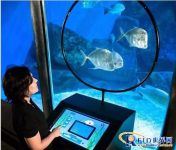
RFID chip fish in the aquarium
[ad_1]
The Virginia Aquarium and Marine Science Center, located in Virginia Beach, places swimming fish in a 45,000-gallon Chesapeake Bay aquarium and records their daily activities to better understand the fish’s health, life span and certain special behaviors . With the implementation of the RFID system, in addition to observing the same information, visitors to the aquarium can also find a rare fish from it and obtain its source, size, growth history, and characteristics of the species. When passing a specific location, all of this information will be displayed on a 23-inch video monitor.
The system includes two parts, a low-frequency (LF) RFID chip implanted in the fish body and an RFID reader installed on the outside of the aquarium, and has been officially put into use. RFID hardware and technical support is provided by a fish and wildlife tracking technology company in Portland, Oregon, USA. The Advanced Institute of System Technology (STAR) provides software for storing and displaying information. It is headquartered in Chesapeake, Virginia, USA.

When the swimming fish enters the range of 9 feet from the reader antenna, the picture and detailed information of the fish will be displayed on the screen
Jeffrey L. Mahon, the director of the aquarium’s exhibits and animals department, has a background in the installation of radio frequency identification technology. He installed a fish RFID tracking system in Singapore’s Underwater World Aquarium in 2007, and a year later in Pattaya, Thailand. The same system is also installed in the underwater world of Ya Beach. According to Mahon, Ocean World Singapore is the first aquarium to use RFID. Therefore, the installation of this equipment has attracted many tourists and increased the number of visitors. The aquarium continues to operate.
Oregon RFID company provides technical support for the aforementioned two Asian marine worlds, and usually sells its technology to track wild animals such as fish in streams and rivers. The 134.2 kHz low-frequency tag produced by Texas Instruments complies with ISO 11784 and 11785 standards and can be used to read tags up to 6 feet deep underwater. Oregon RFID boss Warren Leach said: His company has provided tags and RFID readers for two Ocean Worlds in Singapore and Thailand. The readers used circuit boards produced by Texas Instruments.
For the Virginia Aquarium, Mahon has a new challenge: design a system that can read tags through salt water. The aquarium has implanted low-frequency (LF) tags in some sharks and turtles, but as far as the current system is concerned, the animal can only be taken out of the pool with a handheld reader to read the tag information within a short distance. Mahon said: For the new deployment, about 40 fish were implanted with chips, each weighing about 3 pounds. The chip is implanted in the muscle near the animal’s dorsal fin. The 16-bit code in the tag is related to the fish activity records and species information stored in the software developed by the Advanced Institute of System Technology (STAR).
The Advanced Institute of System Technology (STAR) has been providing interactive software for aquariums since 2004. When Mahon proposed to STAR to trace fish information through RFID technology, this was STAR’s first RFID-based solution, and initially the company had some reservations. “This is a new technology for us,” he said, “but we have done research before.” The company formed an engineering team in January 2011 to develop software through which the tag number in the fish can be related to the fish itself. The data is connected and the effective information is displayed on the touch screen.
The Virginia Aquarium system has been installed, and the RFID reader is installed on the outside of the acrylic plate on the surface of the aquarium. The antenna of the reader can read the code of the tag within a distance of about 9 inches. Mahon said: Due to the salt content of seawater, the reading distance of this reader is shorter. He hopes to expand the reading range by changing the position of the antenna or changing the design of the antenna. He once had this idea: install the reading antenna inside the water tank and put it in a waterproof PVC pipe. During this period, the aquarium has tried a variety of antenna configurations.He said: “Last week, the circle was used[直径约2英尺]Antenna; this week, the rectangle is used[约1英尺,宽4英尺高]; Next week, it is likely to be a vertical line. “
When the fish tag is read, the tag number is forwarded to the STAR software, and a photo and description of the animal passing by the antenna will be displayed on the video screen. After the animal walks, its information remains on the right side of the screen, and when a new animal passes by, its information is displayed in the center of the screen. Visitors can use the touch screen to select fish that have been swimming, and learn more about it.
Mahon hopes to install this system in the freshwater tank of the aquarium, so that the label’s reading range will be wider. He also pointed out that the fish in the freshwater tank swim more slowly, and the information displayed is relatively stable.
Mahon said: “We hope that this system is an example of a new type of sign, which can be used not only in aquariums, but also in zoos.” “Our goal is to bring people closer to animals, and more It is easy to understand its evolutionary history and hope to increase the feelings between people and it. “Although the installation of this system is only one day, tourists have shown great interest in this new way of visiting. In addition, there is a touch screen display in the aquarium, which mainly introduces the implementation process of RFID and explains the working principle of the system.
[ad_2]





